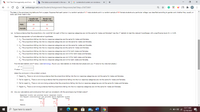
MATLAB: An Introduction with Applications
6th Edition
ISBN: 9781119256830
Author: Amos Gilat
Publisher: John Wiley & Sons Inc
expand_more
expand_more
format_list_bulleted
Topic Video
Question
thumb_up100%
please help!

Transcribed Image Text:A 14.2 Test Homogeneity and Indpi x
b The data summarized in the acco x G screenshot screen on windows - X +
A webassign.net/web/Student/Assignment-Responses/last?dep=25472461
The data in the accompanying table are from a paper. Suppose that each person in a random sample of 47 male students and in a random sample of 89 female students at a particular college was classified according to gender and whether they usually or
rarely eat three meals a day.
Usually Eat
3 Meals a Day
Rarely Eat
3 Meals a Day
Male
25
22
Female
37
52
(a) Is there evidence that the proportions who would fall into each of the two response categories are not the same for males and females? Use the x? statistic to test the relevant hypotheses with a significance level of a = 0.05.
State the appropriate null and alternative hypotheses.
O H,: The proportions falling into the two response categories are the same for males and females.
H: The proportions falling into the two response categories are not the same for males and females.
O H: The proportions falling into the two response categories are not the same for males and females.
H: The proportions falling into the two response categories are the same for males and females.
O H: The proportions falling into the two response categories are 0.5 for both males and females.
H: The proportions falling into the two response categories are not 0.5 for both males and females.
: The proportions falling into the two response categories are not 0.5 for both males and females.
Ho:
H: The proportions falling into the two response categories are 0.5 for both males and females.
Find the test statistic and P-value. (Use technology. Round your test statistic to three decimal places and your P-value to four decimal places.)
x =
P-value =
State the conclusion in the problem context.
O Reject Hn. There is not convincing evidence that the proportions falling into the two response categories are not the same for males and females.
O Fail to reject Hg. There is convincing evidence that the proportions falling into the two response categories are not the same for males and females.
Fail to reject H,. There is not convincing evidence that the proportions falling into the two response categories are not the same for males and females.
O Reject H. There is convincing evidence that the proportions falling into the two response categories are not the same for males and females.
(b) Are your calculations and conclusions from part (a) consistent with the accompanying Minitab output?
Expected counts are printed below observed counts
Chi-3quare contributions are printed below expected count=
Usually
Rarely
Total
Male
25
22
47
21.43
25.57
0.596
0.499
Female
37
52
89
O Type here to search
12:17 AM
A O 49) (a 12/10/2020
W
26
近

Transcribed Image Text:A 14.2 Test Homogeneity and Indpi x
b The data summarized in the acco x G screenshot screen on windows - X +
A webassign.net/web/Student/Assignment-Responses/last?dep=25472461
(b) Are your calculations and conclusions from part (a) consistent with the accompanying Minitab output?
Expected counts are printed below observed counts
Chi-3quare contributions are printed below expected counts
Usually
Rarely
Total
Male
25
22
47
21.43
25.57
0.596
0.499
Female
37
52
89
48.43
40.57
0.315
0.264
Total
62
74
136
Chi-3g = 1.674, DF = 1, F-Value = 0.196
O The calculations and conclusions from part (a) are consistent with the accompanying Minitab output.
O The calculations and conclusions from part (a) are not consistent with the accompanying Minitab output.
(c) Because the response variable in this exercise has only two categories (usually and rarely), you could have also answered the question posed in part (a) by carrying out a large-sample z test of H: P, - P, = 0 versus H: P, - P, + 0, where p, is
the proportion who usually eat three meals a day for males and p, is the proportion who usually eat three meals a day for females. Minitab output from the large-sample z test is shown. Using a significance level of a = 0.05, does the large-sample z
test lead to the same conclusion as in part (a)?
Test for Two Proportions
Sample
Sample p
Male
25
47
0.531915
Female
37
89
0.415730
Difference = p(1) - p (2)
Test for difference = O (vs not = 0): z = 1.29 P-Value = 0.196
O The large-sample z test leads to the same conclusion as in part (a).
O The large-sample z test does not lead to the same conclusion as in part (a).
(d) How do the P-values from the tests in parts (a) and (c) compare? Does this surprise you? Explain.
O The two P-values are equal when rounded to three decimal places. It is not surprising that the P-values are at least similar, since both measure the probability of getting sample proportions at least as far from the expected proportions as what
was observed, given that the proportions who usually eat three meals per day are the same for the two populations.
O The two P-values are equal when rounded to three decimal places. It is surprising that the P-values are so similar, since the P-value from the chi-square test is measuring the probability of getting sample proportions at least as far from the
expected proportions as what was observed, given that the proportions who usually eat three meals per day are the same for the two populations, and the z test is measuring the probability of getting sample proportions closer to the expected
proportions than what was observed, given that the proportions who usually eat three meals per day are the same for the two populations.
O The two P-values are not equal when rounded to three decimal places. It is not surprising that the P-values are different, since the P-value from the chi-square test is measuring the probability of getting sample proportions at least as far from
the expected proportions as what was observed, given that the proportions who usually eat three meals per day are the same for the two populations, and the z test is measuring the probability of getting sample proportions closer to the
expected proportions than what was observed, given that the proportions who usually eat three meals per day are the same for the two populations.
O The two P-values are very different. It is quite surprising that the P-values are this different, since both measure the probability of getting sample proportions at least as far from the expected proportions as what was observed, given that the
proportions who usually eat three meals per day are the same for the two populations.
Submit Answer
P Type here to search
12:17 AM
A O 49) (a 12/10/2020
W
26
Expert Solution
This question has been solved!
Explore an expertly crafted, step-by-step solution for a thorough understanding of key concepts.
This is a popular solution
Trending nowThis is a popular solution!
Step by stepSolved in 3 steps with 1 images

Knowledge Booster
Learn more about
Need a deep-dive on the concept behind this application? Look no further. Learn more about this topic, statistics and related others by exploring similar questions and additional content below.Similar questions
Recommended textbooks for you
 MATLAB: An Introduction with ApplicationsStatisticsISBN:9781119256830Author:Amos GilatPublisher:John Wiley & Sons Inc
MATLAB: An Introduction with ApplicationsStatisticsISBN:9781119256830Author:Amos GilatPublisher:John Wiley & Sons Inc Probability and Statistics for Engineering and th...StatisticsISBN:9781305251809Author:Jay L. DevorePublisher:Cengage Learning
Probability and Statistics for Engineering and th...StatisticsISBN:9781305251809Author:Jay L. DevorePublisher:Cengage Learning Statistics for The Behavioral Sciences (MindTap C...StatisticsISBN:9781305504912Author:Frederick J Gravetter, Larry B. WallnauPublisher:Cengage Learning
Statistics for The Behavioral Sciences (MindTap C...StatisticsISBN:9781305504912Author:Frederick J Gravetter, Larry B. WallnauPublisher:Cengage Learning Elementary Statistics: Picturing the World (7th E...StatisticsISBN:9780134683416Author:Ron Larson, Betsy FarberPublisher:PEARSON
Elementary Statistics: Picturing the World (7th E...StatisticsISBN:9780134683416Author:Ron Larson, Betsy FarberPublisher:PEARSON The Basic Practice of StatisticsStatisticsISBN:9781319042578Author:David S. Moore, William I. Notz, Michael A. FlignerPublisher:W. H. Freeman
The Basic Practice of StatisticsStatisticsISBN:9781319042578Author:David S. Moore, William I. Notz, Michael A. FlignerPublisher:W. H. Freeman Introduction to the Practice of StatisticsStatisticsISBN:9781319013387Author:David S. Moore, George P. McCabe, Bruce A. CraigPublisher:W. H. Freeman
Introduction to the Practice of StatisticsStatisticsISBN:9781319013387Author:David S. Moore, George P. McCabe, Bruce A. CraigPublisher:W. H. Freeman

MATLAB: An Introduction with Applications
Statistics
ISBN:9781119256830
Author:Amos Gilat
Publisher:John Wiley & Sons Inc

Probability and Statistics for Engineering and th...
Statistics
ISBN:9781305251809
Author:Jay L. Devore
Publisher:Cengage Learning

Statistics for The Behavioral Sciences (MindTap C...
Statistics
ISBN:9781305504912
Author:Frederick J Gravetter, Larry B. Wallnau
Publisher:Cengage Learning

Elementary Statistics: Picturing the World (7th E...
Statistics
ISBN:9780134683416
Author:Ron Larson, Betsy Farber
Publisher:PEARSON

The Basic Practice of Statistics
Statistics
ISBN:9781319042578
Author:David S. Moore, William I. Notz, Michael A. Fligner
Publisher:W. H. Freeman

Introduction to the Practice of Statistics
Statistics
ISBN:9781319013387
Author:David S. Moore, George P. McCabe, Bruce A. Craig
Publisher:W. H. Freeman